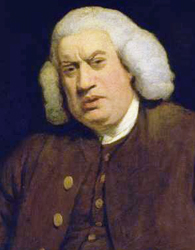Not only did Samuel Johnson’s work define the literature of the 18th century, his dictionary defined the language. Sometimes called “the great convulsionary” for his twitches and tics, Johnson pulled himself up from a poor, sickly son of a bookseller to become one of the most famous writers of the 1700s.
Samuel Johnson’s Early Days
Born September 18, 1709, above his father’s bookstore in Lichfield, Staffordshire, England, Samuel Johnson was apparently imbued with the literary spirit from the moment of his birth.
Unfortunately, he seemed to be blessed with little else. His mother had a difficult labor and he was not expected to make it through the night. Obviously, he did survive, but he could never be described as a child who thrived. Samuel Johnson was frequently sick, suffering from tuberculosis and other maladies, including severe nearsightedness, partial deafness and scarring across much of his body.
Sources in this Story
- The Samuel Johnson Sound Bite Page: Brief Biography
- Rutgers University: Professor Jack Lynch’s Guide to Johnson—The Dictionary
- Rutgers University: Rambler 156
- Journal of the Royal Society of Medicine: Doctor Samuel Johnson
- Derbyphotos.co.uk: 2005 Wedding of Dr Samuel Johnson re-enactment
- Dr. Johnson’s House
While his body suffered, Johnson worked on enriching his mind. He was a voracious reader and translated poems from Latin at an early age. He was easily admitted to Pembroke College, Oxford, but left before graduation because of financial difficulties. He was later awarded honorary Master’s and doctorate degrees, and thereafter most referred to him as “Doctor Johnson.”
Johnson’s Notable Accomplishments
In 1755, after nine years of solitary work, Johnson published “The Dictionary of the English Language.” While it was not the first dictionary, Johnson’s was the first to use quotations to illustrate word usage.
The two-volume reference was the standard for 150 years after it was published, and is widely considered to be the basis for the Oxford English Dictionary. It contained more than 4,000 words and definitions and covered topics ranging from pop culture to sex to traditional society.
He also dabbled in poetry, political writing and fiction. For two years he anonymously penned a twice-weekly newsletter called “The Rambler”, which sold for twopence and covered topics ranging from morality to the human experience.
James Boswell wrote a biography of his close friend Johnson that was published in 1791. It was through this and the many other biographies written by his friends that Johnson truly gained fame.
The Man and his Work
- “A Dictionary of the English Language” by Samuel Johnson
- “Samuel Johnson: The Major Works”
- “Selected Essays” by Samuel Johnson
- “Johnson’s Lives of the Poets, Volume 1”
- “Life of Johnson” by James Boswell
The Rest of the Story
Diagnosed posthumously with Tourette’s syndrome, a disorder of the nervous system which is characterized by involuntary movements and vocalizations, though many sources indicate Johnson’s twitches and tics were misinterpreted as general weirdness when he was alive.
Frances Reynolds, a friend of Johnson’s, recalled his tics and rituals as a public embarrassment: “I well remember that they (his gestures) were so extraordinary that men, women and children gathered around him laughing…and they nearly dispersed when he pulled out of his pocket Grotius’ De Veritate Religionis, over which he see-sawed at such a violent rate as to excite the curiosity of some people at a distance to come and see what was the matter with him.”
Johnson was married in 1735 to Elizabeth Porter, a widow more than 20 years older than he was. The two did not have children and Porter died in 1752 after a bout of ill health. Johnson died December 13, 1784, in London.
Although it’s been centuries since the blessed event, a church in Derbyshire holds a reenactment of the wedding each year on July 9. The wedding is just one in a number of modern-day events celebrating the author; he has inspired birthday celebrations, societies of fans on three continents and his London home has also been turned into a museum.
This article was originally written by Jennifer Ferris; it was updated September 9, 2017.











